1980 French Grand Prix race report
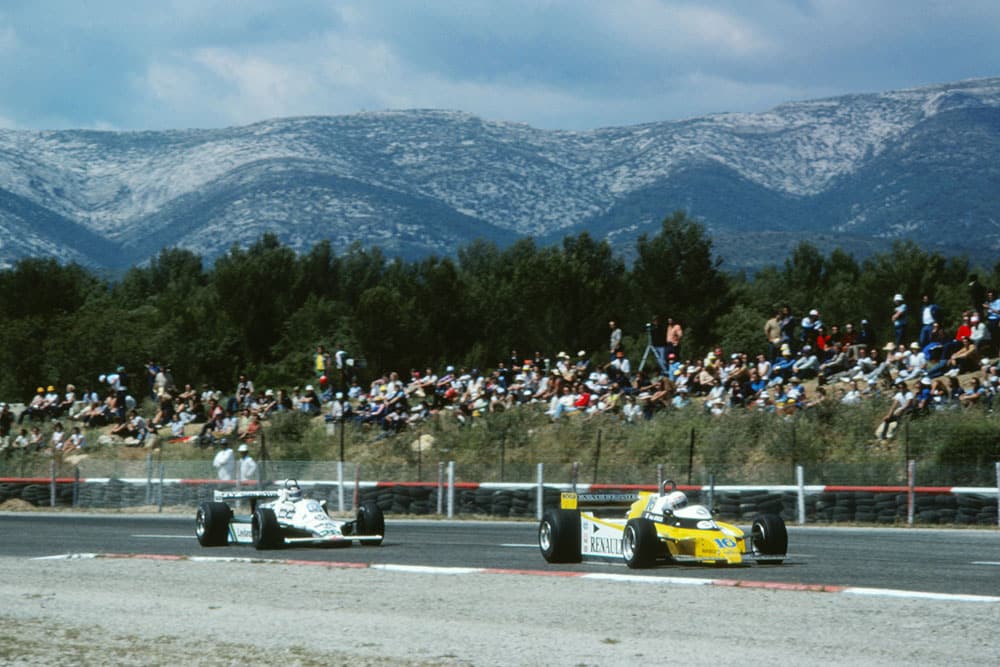
Rene Arnoux's Renault is chased by the Williams of Carlos Reutemann
Motorsport Images
Typically Jones
Paul Ricard, Castellet, June 29th
There was never any doubt that the French Grand Prix was going to happen, the only question mark was whether “Bernie’s Boys” were going to join the three manufacturers teams that had entered. All the fines imposed on the drivers for their misconduct in Belgium had been paid, so everyone was in order to compete, provided they had a suitable car. The week before the event was rife with interesting rumour, that (a) Bernie was not going to allow his FOCA teams to take part. (b) that certain sponsors like ELF, Marlboro, Parmelat, Gitanes and Goodyear were getting a little tired of all the nonsense, (c) that the French would run the race with seven cars and (d) Renault were saying they could enter a third car if another French driver could be found willing to break ranks and join Jabouille and Arnoux. The teams of Ligier, Tyrrell, and McLaren were fingering their contracts. In the end it all turned out “happily ever after” (or so we are told) and the FOCA teams climbed down and everyone turned up at the wind-swept and dusty Paul Ricard racing complex in time to start practice on Friday morning at 10 am.
It was just after 11 am before it all got under way, for at the last moment the medical helicopter, which was the province of the Gendarmerie Nationale, was called away because the French farmers were threatening all sorts of dire things in the locality. Eventually another medically-equipped helicopter was hired and the game began. There were a few changes here and there along the pit lane, though none of great significance. The young Swiss Driver Marc Surer was now fit after his accident in South Africa and returned to the ATS team, which meant that the forceful little Dutchman Jan Lammers was out of a job, so Morris Nunn snapped him up for the Ensign team, having dropped Needell and Gaillard. In the Williams team the mechanics had added MBE under the name of their number one driver, following the Australian’s Royal award, and everyone fussed about their gear ratios because the Mistral was blowing along the straight at a very helpful 10-15 knots and the dust was swirling into the clean blue sky.
Qualifying
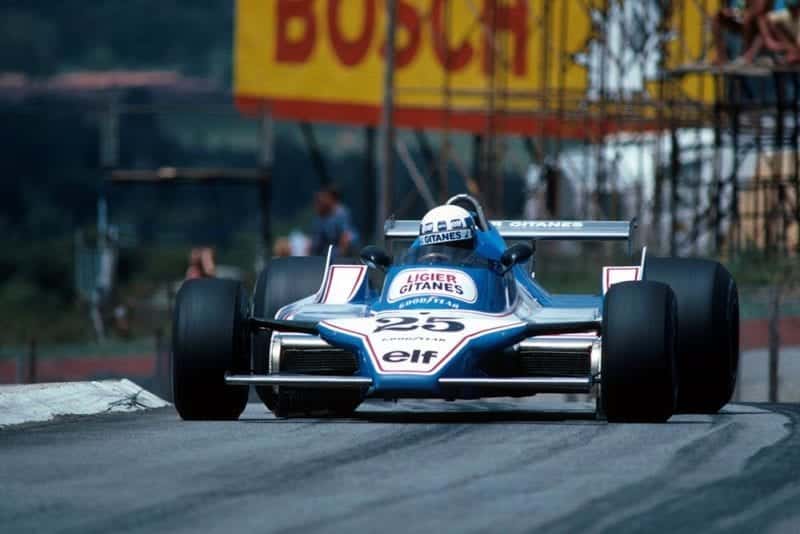
Didier Pironi qualified 3rd for Ligier
Motorsport Images
It was thought that Renault’s were going to run away on this circuit, with the 1.8 kilometres back straight, but it did not take long during the hour and a half of testing to realise that something was going wrong. Admittedly Arnoux and Jabouille were recording the highest speeds through the timing beams at the end of the straight, with well over 190 but the Ligiers and the Williams were easily matching them on lap times. The reasons were technically very interesting and are enlarged upon elsewhere in this issue, but basically it was a case of the circuit offering the choice of the ultimate speed or ultimate cornering, or combination of both, any one of the three able to provide the same result, but all centred around the crucial long straight and its entry corner and its exit corner. The first sign of trouble in the Renault team came when Jabouille arrived at the pits with a merry oil fire going on in the engine compartment, a piston had failed and oil had been pumped out of everywhere onto the red-hot exhaust pipes and turbo-charger. Apart from the blown up engine the damage was fairly light but it meant that Jabouille had to take the spare car for the afternoon timed session. In the next pit the Ferrari team looked on with interest, knowing it would be their turn next to cope with highly supercharged 11/2-litre engines, though at the moment they were more concerned with the fact that the T5 could not make full use of its Michelin tyres, no matter how Villeneuve tried. Both Ferrari drivers were so far back that one or two of the back-field drivers could have been forgiven for getting excited.
For the one hour timed session in the afternoon the wind was as strong as ever, but at least the skies stayed clear and blue. The 10 knot wind on the back straight occassionally gusted up to 20 knots and most of the time was nearer 15 and terminal speeds were anywhere between 180 m.p.h. and 196 m.p.h., depending on whose timing beam readings you looked at, and there was one from each of the more serious teams. However, terminal speeds did not get you a place on the grid, nor did lap times taken by individual time-keepers; it was the lap times taken by the official time-keepers that counted. It wasn’t long before a Ligier, a Williams and a Renault were recording times close to 1 min 40 sec and then breaking into rho 1 min 39 sec bracket. The Grand Prix cars had not raced at the Paul Ricard circuit since 1978, at which time they left the lap record at 1 min 48.56 sec courtesy of Carlos Reutemann with a T3 Ferrari and fastest practice lap that year was by John Watson with a flat-12 Alfa Romeo engined Brabham in 1 min 44.41 sec. Already it was very clear that the old lap record was nothing to aim for and it was quickly transpiring that Watson’s fastest practice lap of 1978 would not qualify for this year’s select 14 starters. (We are making progress towards the ultimate goal!)
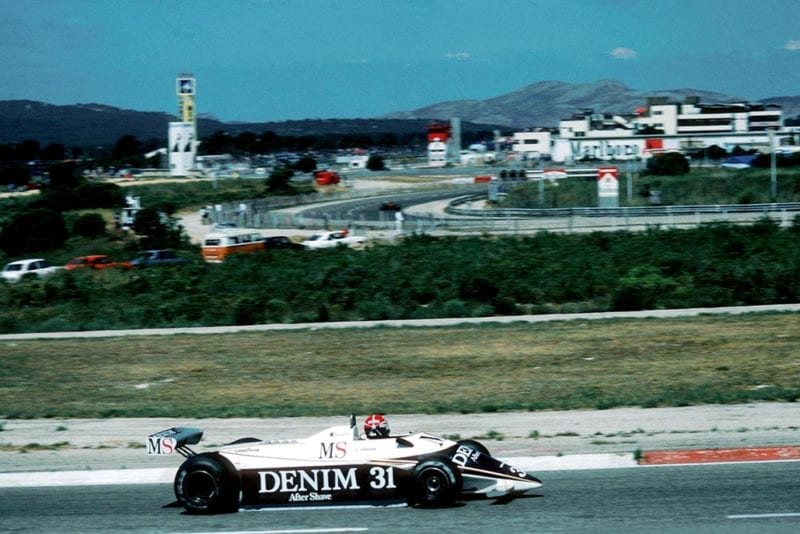
After qualifying Eddie Cheever found himself down in 21st
Motorsport Images
Laffite was in the spare Ligier, with the latest body panels fitted and it was obviously set up for ultimate times rather than race conditions. Arnoux was in as good a form as ever and the deceptive Pironi was the fastest of all though the long curve at the end of the straight. Both Williams drivers were in there with them, Jones trying the spare car and going a little bit quicker in it than in his race-car. This was a bunch of really hard runners up at the front, all of them out to win whatever the prize and it was a pity tha Brabhams could not get their cars balanced right between speed and handling to allow Piquet to be in there with them. Saddest of all was to see the Ferraris down among the lower mid-field also-rans, their handling looking awful at high speed compared with the top runners. Their Michelin tyres looked the same as those on the Renaults, but the Ferrari chassis was obviously not making the most of the rubber as the French cars were. Down at the back of the field Lammers was driving the Ensign MN12 as the later car was still being worked on, but he could not match the times he could have done in the ATS and was not even as fast as Surer in the Anglo-German car: which must prove something or other. Of the mid-field lot, and sadly that still includes the Lotus team with their opulent looking Essex-backed cars, McLaren were showing improvement with Prost up in eighth place, but still nearly two seconds off pole position.
The Ligiers were the undoubted pace-setters and both drivers were well in the 1 min 39 sec bracket, but Arnoux Reuteman and Jones were hard behind. If you could not get below 1 min 40 sec you were not going to be in the race for the lead, and if you could not get below 1 min 44 sec you might not even get the grid! In the moments of this critical hour Laffite set new standards with a time of 1 min 38.88 almost 10 seconds under the existing lap and five and a half seconds better than the pole-position time. When it was all over you felt that a big spring, which was wound up tight, had been released. It was something of a relief to watch the gentle passage of the historic cars which came afterwards. A nice gentle ERA, 250F or Bugatti was very relaxing after 500 bhp/12,000 rpm/1.320 lb. projectiles driven by hard and determined men like Laffite, Arnoux, Reutemann and Jones.
On Saturday morning the wind had but the skies were still blue and the session began on schedule. Another engine been installed in Jaboille’s Renault RE23, Joneswas “trying things out” in the spare Williams. Scheckter was using the mulatto Ferrari while own car was having the engine changed. The second Ensign (MN 14) was finished and running, Depailler was becoming more convinced about the smaller-engined Alfa Romeo and was planning to race it, and everything was boiling up nicely for the final timed practice session. Still the Ligiers were fastest but the Williams team were pretty confident they could deal with them on race day, though Renault’s confidence took a had knock when Arnoux’s engine went sick with a leaking head joint. As the spare car is tailored to the lanky Jabouille there was a panic change of engine on RE24 for Arnoux. Before the morning session ended there was gloom in the Ensign camp, for Lammers crashed the MN14 pretty extensively, and they had just finished fitting a whole new skirt system to the car. The Brabham team were at work on Zunino’s car with the engine out to cure an oil leak, and the de Angelis Lotus was receiving a lot of mechanical attention.
It began to get very hot in the afternoon with a lot less wind than the day before, and while the heat was good for tyres and their stickyness it was bad for engines, especially while holding maximum rpm for over a mile on the back straight. Jabouille’s Renault had not been going properly in the morning so he used RE22 for the afternoon session and Scheckter was still in the T-car while his own was being finished off. Lammers was in Ensign MN12 and Piquet was in the spare Brabham trying 15″ diameter front tyres among other things. Zunino and de Angelis were both having to miss the first part of the crucial final hour while mechanics slaved away to finish work on the cars. Arnoux completed four laps in the Renault RE24 with its new engine, recording 1 min 39.86 sec, when there was a big bang and oil everywhere as another turbo V6 engine expired. Consternation was building up in the Renault camp and it reached its peak when Jabouille arrived at the pits with another oil fire underway in the back of the car. The engine had blown up at the end of the straight and the hot turbine had set fire to the oil that blew out everywhere. The team had now consumed four engines and none of their cars were runners. Unlike some lesser teams who slam the door in your face under adversity the Renault team remained remarkably affable, but with furrowed brows. In the background there was serious discussion going on amongst Renault and ELF engineers and the “big wheels” of those two companies.
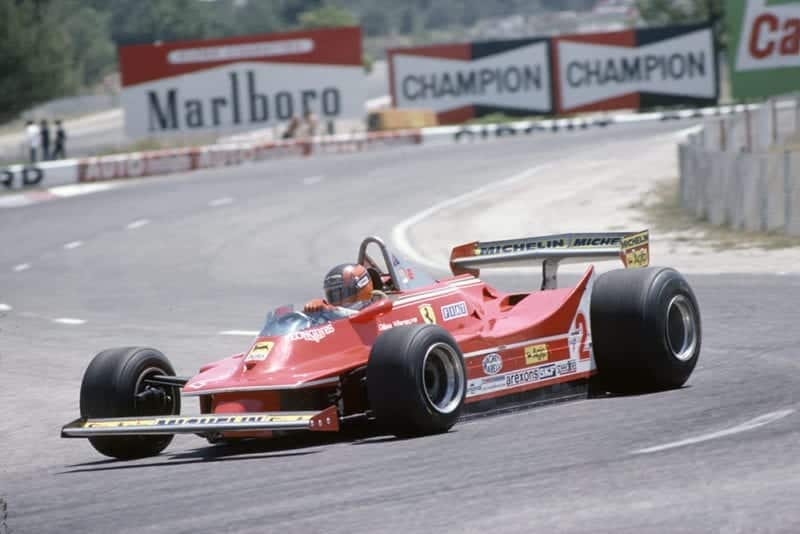
Gilles Villeneuve continued his difficult season with 17th on the starting grid
Motorsport Images
Meanwhile the Ligiers were pounding round remarkably trouble free with the Williams cars hard behind them. The time that Arnoux had set the day before was still good for second place on the grid, but as Pironi and Jones approached it there was nothing the Renault driver could do to defend his position. With less wind and more heat it was proving difficult to improve on Friday’s time, but even so Arnoux’s position was very tenuous. On Friday Arnoux had recorded 1 min 39.49 sec and now Pironi had equalled it, while Jones was only one hundredth of a second away, but try as they might neither of them could improve. Laffite could not match his Friday time, but that didn’t matter as it was secure for pole-position. Pironi and Jones were in the second row and all the Frenchman needed was an improvement of one hundredth of a second to move up on the front row, while Jones needed two hundredths. When you look at a hundredth of a second on a stop-watch it seems unreal, but it makes you realise what a knife-edge the top runners are on and how changing conditions of track or car can stop your progess no matter how hard you try. In a vain effort to get Pironi on the front row the two Ligier drivers went out together to “leap-frog” (frog!) each other down the straight, using each other’s slip-stream to try and get that vital improvement, but the track surface had deteriorated with rubber and oil and heat. Jones was trying his utmost right to the end, while poor Arnoux could only stand and watch. Once again there was enormous relief when the chequered flag came out, some teams breathing a sigh of relief, others depressed and some content. Ligier were pretty confident, Williams were grimly determined, Renault were baffled, Ferrari bewildered and Brabharn sad. “There’s a McLaren ahead of us” said Gordon Murray.
The fastest 24 of the two days were in the race and Ensign were far from happy with a badly crashed car and the other in 26th place. while Shadow failed to qualify both their cars, which is becoming a habit. Ferrari were in unbelievable 17th and 19th places, among the Arrows and Tyrrells and not far from the Fittipaldis. Marc Surer was in a very respectable 11th place in the ATS, which says a lot for the yellow one against the red, white and blue Ensign that didn’t qualify. The timed hour runs from 1 pm to 2 pm so everyone has lunch after it is all over and it was a very joyous Ligier team who sat down to their open-air lunch “en famile”, with Guy Ligier at the head of the table full of mechanics and engineers, and the two drivers at the opposite end of the table. Not only were they first and third on the grid, they were the top French team in their own Grand Prix and earlier in the week Guy Ligier had signed over a big share of his team to a combine of Talbot and Matra in readiness tor 1981. In the back of the Renault pits the top-brass of Billancourt and Elf were still in discussion and looking very senous and not a little worried. The engine failures seem to have started in the area of the pistons (made in Germany by Mahle) but the reason was not clear. They were still running 1.8 atu of boost and temperatures were all quite normal; they had good reason to be worried.
Race
After all manner of sideshows and exhibitions on Sunday morning with the wind getting up again the half-hour warm-up before the 54 lap Grand Prix took place just after mid-day. The ELF people had checked and analysed the petrol that Renault were using and found nothing wrong, and anyway it was the same as Ligier and several other teams were using, so Renault re-set the boost a little lower on the two new engines installed in the RE23 and RE24, for Jabouille and Arnoux, respectively. In the Arrows team Patrese was using the long tail on his car. while Mass was using the short tail. Lotus and Williams were using the new 15″ diameter front tyres from Goodyear, though Brabham and Ligier were on the 13″ Goodyears. Piquet was about to try both on his car and the spare, with different suspension settings redo a direct comparison and Laffite was destined to use the spare Ligier, for his own car had sprung a petrol leak within the monococque overnight and it was not instantly repairable. The spare Ligier had been re-set to as near the race-car as possible but there was insufficient time for fine adjustments. Depailler was happy to use the experimental car with the lower engine, and Villeneuve was just going to drive as hard as he could and enjoy himself regardless of the outcome.
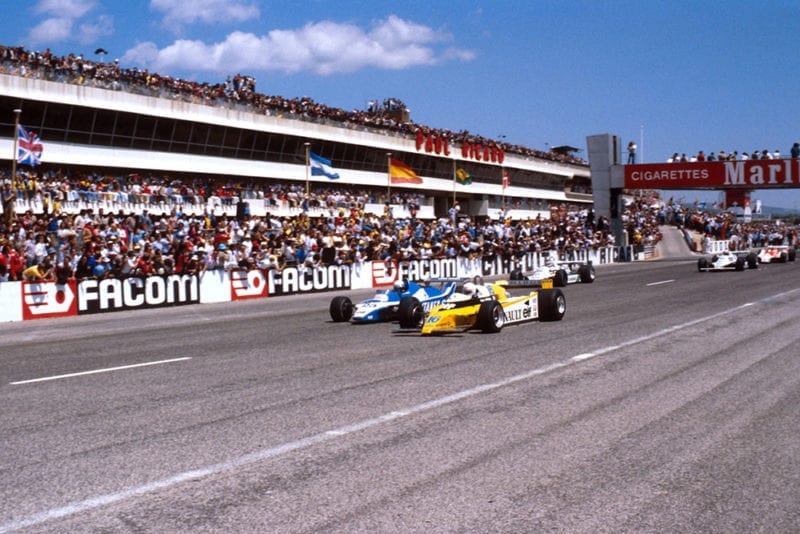
Rene Arnoux leads Didier Pironi at the start
Motorsport Images
The wind was becoming really tiresome as the starting time of 3 pm drew near, but thankfully the sun was shining, though the air was dusty. All 24 qualifiers set off from the pits to drive round to the grid and when all were assembled they were given the “off’ for the parade lap, which Laffite led at a pretty fast pace. Back on the grid they were held for a long time before the green light came on and released them. Laffite made a scorching start from pole position leaving everyone standing. Jabouille’s Renault broke its gearbox as the car started to move and Daly and de Angelis had cooked their clutches in the long delay and had trouble getting going.
Laffite was waiting for no-one, not even his team-mate, and pulled out an enormous lead on the opening lap, but from the word go Piquet (Brabham) and Villeneuve (Ferrari) were scrabbling past other cars in the burly-burly of the opening lap. Pironi was in second place for a lap, but then Arnoux was by, in spite of being down on power, and then Jones; Piquet scratched past Reutemann to take fifth place, while Prost passed the Williams number two on the next lap making the order after three laps Laffite out on his own, Arnoux, Jones, Pironi, Piquet, Prost, Reutemann and Villeneuve. The Lotus of de Angelis was in the pits for attention to the clutch and then Prost dropped from the running to change to a different set of tyres. Although Arnoux was trying as hard as he could he was holding up the bunch behind him, which benefited Laffite who was way into the distance, but not at all happy for his car had too much under-steer on some of the fast bends and obviously the front tyres were going to suffer.
On lap five there was a reshuffle as Pironi passed Jones and Jones passed Arnoux, so that the order became Laffite, Pironi, Jones, Arnoux, Piquet, Reutemann and the remarkable Villeneuve hanging on to this leading group. His World Champion team-leader was not enjoying himself and was way down the back behind Cheever in the Osella, with only Daly behind him. On lap eight Jones took second place from Pironi and the two of them kept within sight of Laffite but too far back to worry him, at least as long as his tyres lasted. Arnoux was having a terrible time with the Renault as the boost pressure was falling and the delay on pick-up was getting really bad. Lesser drivers would have given up the unequal struggle, but not the wiry little Frenchman. He continued to put all he could into his driving and he held Piquet at bay until lap 11 and then had Reutemann looming up in his mirrors, with the red Ferrari still hanging on. Depailler was leading the rest in his Alfa Romeo, with Surer keeping the ATS well up behind the Italian car, but the rest were already trailing a long way behind. Scheckter stopped to change tyres after 10 laps, but little good it did him, and now he really was last, and Andretti was also into the pits complaining that he couldn’t select fourth gear, but all this stuff down at the back was of little importance for up at the front the hard-chargers were all still at it, and they don’t come any harder than Laffite, Jones, Pironi, Piquet, Arnoux, Reutemann and Villeneuve. Anyone who thinks Formula One is a “kid’s game” should try mixing it with that little lot sometime. What had been a 15 second advantage for Laffite was now dwindling rapidly as his front tyres were wearing and the Ligier began to drop back into the clutches of the Jones/Pironi duo. The Australian was smiling to himself for he knew now that it was only a matter of time before he took the lead. His Williams was handling perfectly, the 15″ front tyres were retaining their characteristics constant, as Goodyear technicians said they should, and any advantage that Pironi had down the straight and on the fast corner at the end, Jones could more than wipe out by his superior handling at the far end of the circuit, and in particular through the long right-hander and the fast left-hander leading onto the straight, which meant that he could lead Pironi comfortably into the twists and turns at the end of the lap. Having got all that worked out the crafty Aussie (shades of Jack Brabham!) could concentrate on hauling in the unfortunate Laffite.
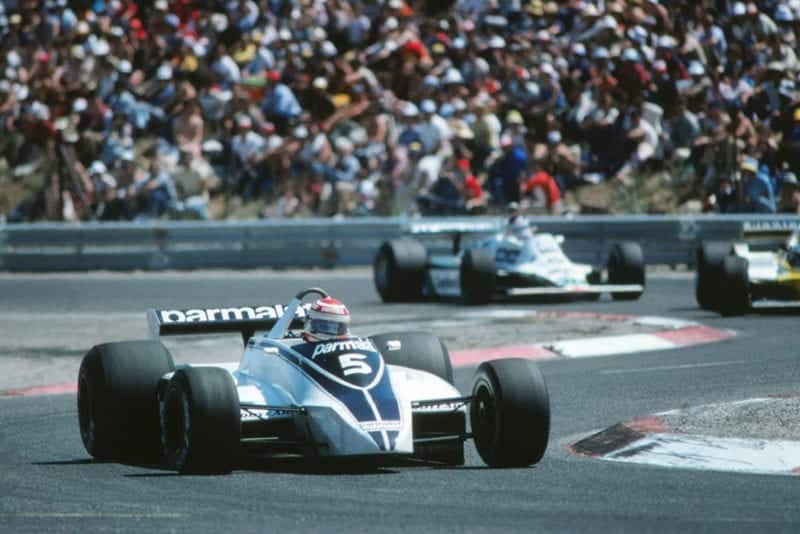
4th wasn’t enough to prevent Nelson Piquet being overhauled by Jones in points standings
© Motorsport Images
It wasn’t all that easy for Laffite doesn’t give up, but the gap was closing fraction by fraction until the Williams was with the Ligier on lap 32, still with the second Ligier close behind in third place. Piquet was a lonely fourth and Arnoux was still in front of Reutemann in fifth place but Villeneuve had been forced to stop at the pits for change of tyres. Totally undaunted he took off back into the race at such a speed that he virtually became airborne over the ramp leading from the pit road onto the circuit. This stop dropped him almost to the back of the field, behind Watson, Patrese, Mass and Fitipaldi. but he was soon catching them. Meanwhile Scheckter had been lapped by the cadets. There was a big gap where the midfield-runners had been for both Alf Romeos had retired, Depailler with a seized shock-absorber and Giacomelli with a peculiar feel to the handling and steering as if somethinj had broken somewhere: Surer had gone out with gearbox failure.
As the leaders started lap 35 it was all over, Jones was just waiting his opportunity, which came at the slow corners at the far end of the circuit. Laffite made no effort to block the Williams, there was no point. and Jones was by and away, though Pironi dropped in behind his team-mate for he knew there was nothing he could do about the Australian. The leading Williams was running perfectly and it pulled away from the two Ligiers while the French team groaned in despair; the Saudi Arabian-backed British team had driven the “frogs’. into the ground, but it had been hard work. A long way back came the lonely Piquet, still driving hard, for behind him Arnoux was keeping in front ol Reutemann by sheet gutsy driving, overcoming his lack of power and poor throttle response by sheer-hard graft. So hard, in fact, that he had bitten through his lip with concentration and determination. The rest had been lapped by the leader and Watson was leading them, though Villeneuve had caught and passed Fittipaldi, Mass and Patrese since his pit stop, and was now closing on the McLaren.
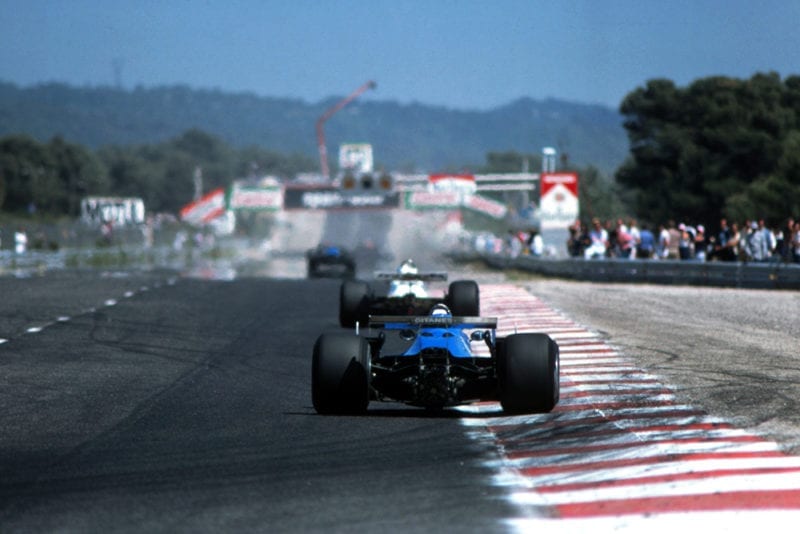
The fight continues unabated as Pironi chases down Jones
Motorsport Images
With 11 laps left to run Pironi was forced to go by his team-leader for Laffite was slowing visibly as his front tyres deteriorated, but he could afford to ease right off as Piquet was too far behind to catch him. Going as hard as ever Jones reeled off the closing laps and came home a comfortable and worthy winner of the French Grand Prix. As he finished his slowing-down lap one of the Williams team handed him a large Union Jack and he drew to a stop amidst the reception with the flag flying proudly in the strong French Mistral that never relented all day. It had been a good race. Won so typically by the broad-shouldered. hard-nut Australian who is beginning to dominate the scene not by inspired brilliance but by determined application to the job in hand, backed by a very strong team of designers, engineers and mechanics, who provide him with the best tools to do the job.
It may not have been a French victory in their home Grand Prix, nor the Renault walk-over that was expected, but French drivers were second, third and fourth. DSJ.
Ricard Ripples:
Fittipaldi stopped on lap 50 when his Cosworth engine died. After the race his mechanics went to collect the car and it started instantly having cooled down! The vaguaries of the racing machine.
Unipart laid on some lavish hospitality for their many guests only to have their car fail to quailify. Sometimes you can’t win anything at all.
Before half-distance Team Lotus had gone from the scene and their going was hardly noticed. Things must get better, they can’t get any worse.
